Analysing Organisational Behaviour: P&G's Culture, Power & Motivation
VerifiedAdded on 2023/06/14
|18
|6018
|192
Report
AI Summary
This report provides a comprehensive analysis of organisational behaviour within Procter & Gamble (P&G), focusing on the interplay between culture, politics, power, and motivation and their impact on team and organisational success. It evaluates how P&G's culture, politics, and power dynamics influence individual and team behaviour and performance. The report critically assesses the application of behavioural and motivational theories to influence behaviour effectively, examining both content and process theories of motivation and motivational techniques used at P&G. Furthermore, it analyses team development theories in the context of P&G's organisational behaviour, suggesting improvements for behaviour and performance. Finally, the report applies and evaluates concepts and philosophies of organisational behaviour to understand their influence within P&G, providing a holistic view of organisational dynamics and their practical implications.
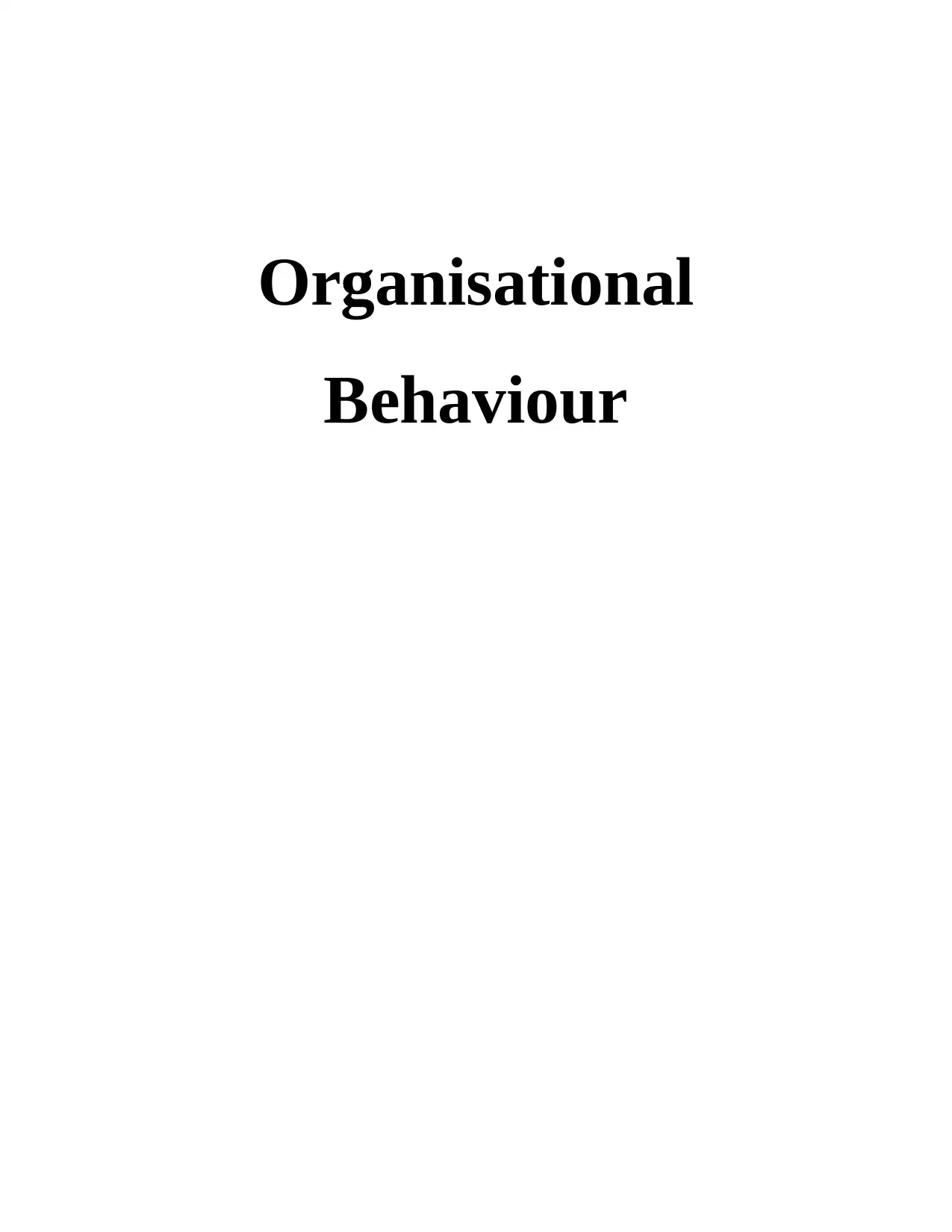
Organisational
Behaviour
Behaviour
Paraphrase This Document
Need a fresh take? Get an instant paraphrase of this document with our AI Paraphraser
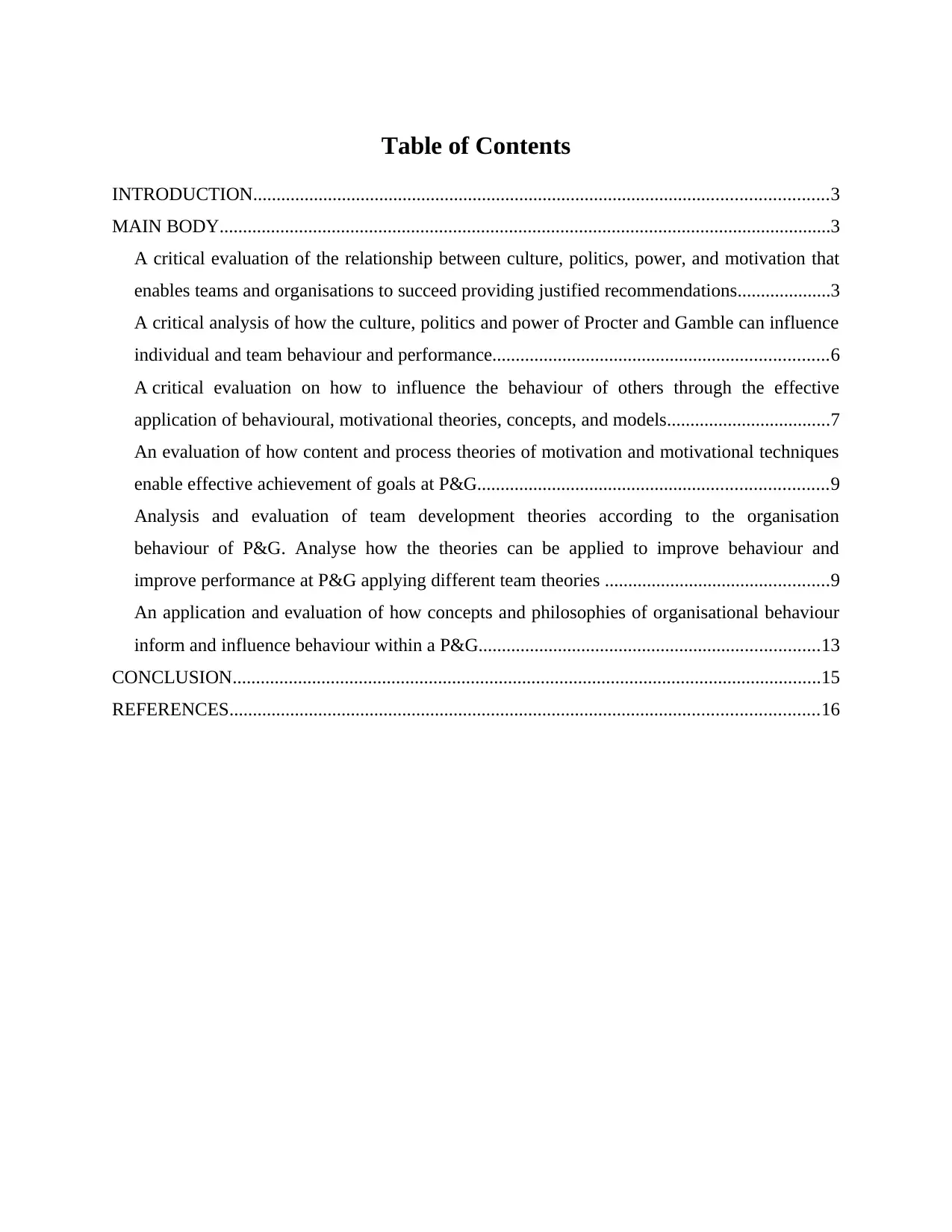
Table of Contents
INTRODUCTION...........................................................................................................................3
MAIN BODY...................................................................................................................................3
A critical evaluation of the relationship between culture, politics, power, and motivation that
enables teams and organisations to succeed providing justified recommendations....................3
A critical analysis of how the culture, politics and power of Procter and Gamble can influence
individual and team behaviour and performance........................................................................6
A critical evaluation on how to influence the behaviour of others through the effective
application of behavioural, motivational theories, concepts, and models...................................7
An evaluation of how content and process theories of motivation and motivational techniques
enable effective achievement of goals at P&G...........................................................................9
Analysis and evaluation of team development theories according to the organisation
behaviour of P&G. Analyse how the theories can be applied to improve behaviour and
improve performance at P&G applying different team theories ................................................9
An application and evaluation of how concepts and philosophies of organisational behaviour
inform and influence behaviour within a P&G.........................................................................13
CONCLUSION..............................................................................................................................15
REFERENCES..............................................................................................................................16
INTRODUCTION...........................................................................................................................3
MAIN BODY...................................................................................................................................3
A critical evaluation of the relationship between culture, politics, power, and motivation that
enables teams and organisations to succeed providing justified recommendations....................3
A critical analysis of how the culture, politics and power of Procter and Gamble can influence
individual and team behaviour and performance........................................................................6
A critical evaluation on how to influence the behaviour of others through the effective
application of behavioural, motivational theories, concepts, and models...................................7
An evaluation of how content and process theories of motivation and motivational techniques
enable effective achievement of goals at P&G...........................................................................9
Analysis and evaluation of team development theories according to the organisation
behaviour of P&G. Analyse how the theories can be applied to improve behaviour and
improve performance at P&G applying different team theories ................................................9
An application and evaluation of how concepts and philosophies of organisational behaviour
inform and influence behaviour within a P&G.........................................................................13
CONCLUSION..............................................................................................................................15
REFERENCES..............................................................................................................................16
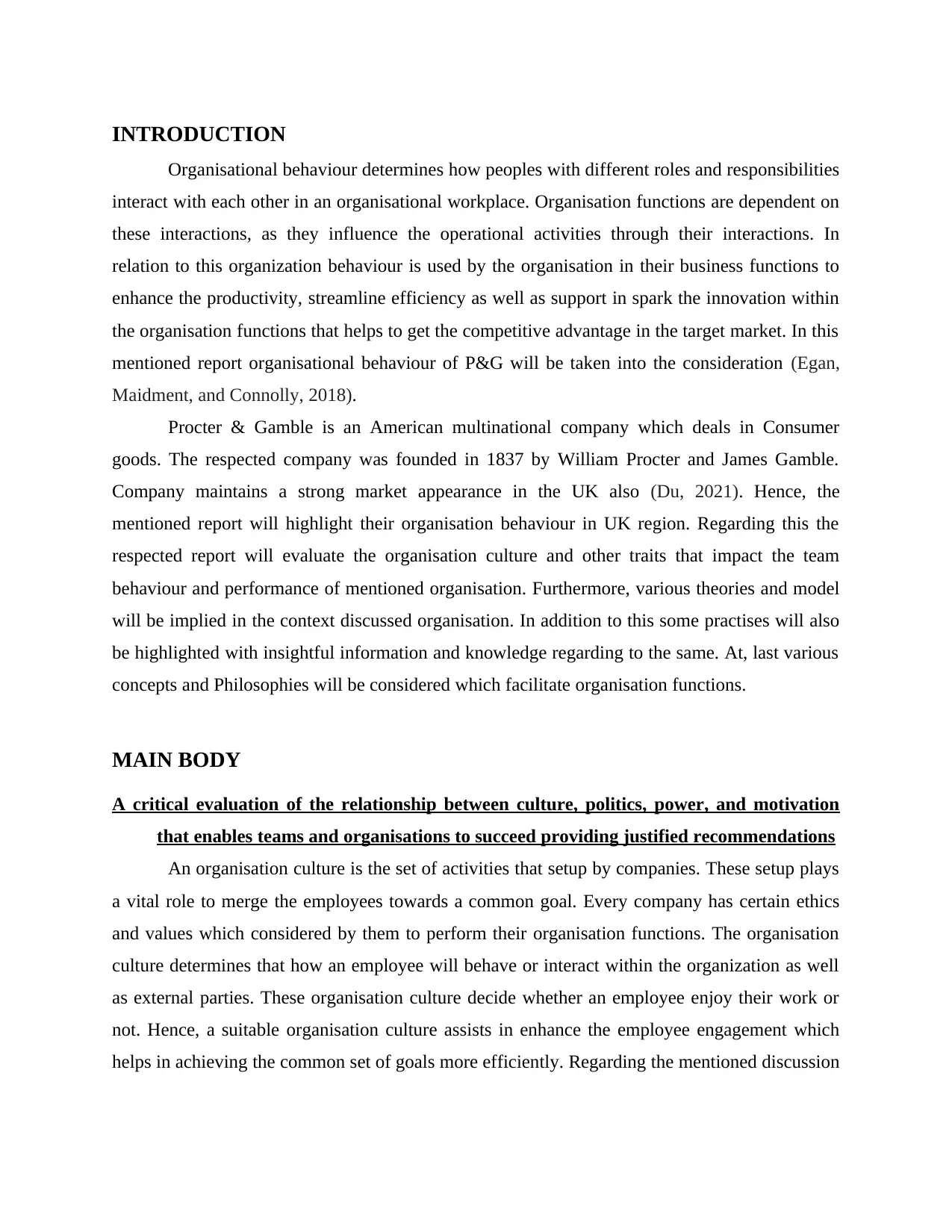
INTRODUCTION
Organisational behaviour determines how peoples with different roles and responsibilities
interact with each other in an organisational workplace. Organisation functions are dependent on
these interactions, as they influence the operational activities through their interactions. In
relation to this organization behaviour is used by the organisation in their business functions to
enhance the productivity, streamline efficiency as well as support in spark the innovation within
the organisation functions that helps to get the competitive advantage in the target market. In this
mentioned report organisational behaviour of P&G will be taken into the consideration (Egan,
Maidment, and Connolly, 2018).
Procter & Gamble is an American multinational company which deals in Consumer
goods. The respected company was founded in 1837 by William Procter and James Gamble.
Company maintains a strong market appearance in the UK also (Du, 2021). Hence, the
mentioned report will highlight their organisation behaviour in UK region. Regarding this the
respected report will evaluate the organisation culture and other traits that impact the team
behaviour and performance of mentioned organisation. Furthermore, various theories and model
will be implied in the context discussed organisation. In addition to this some practises will also
be highlighted with insightful information and knowledge regarding to the same. At, last various
concepts and Philosophies will be considered which facilitate organisation functions.
MAIN BODY
A critical evaluation of the relationship between culture, politics, power, and motivation
that enables teams and organisations to succeed providing justified recommendations
An organisation culture is the set of activities that setup by companies. These setup plays
a vital role to merge the employees towards a common goal. Every company has certain ethics
and values which considered by them to perform their organisation functions. The organisation
culture determines that how an employee will behave or interact within the organization as well
as external parties. These organisation culture decide whether an employee enjoy their work or
not. Hence, a suitable organisation culture assists in enhance the employee engagement which
helps in achieving the common set of goals more efficiently. Regarding the mentioned discussion
Organisational behaviour determines how peoples with different roles and responsibilities
interact with each other in an organisational workplace. Organisation functions are dependent on
these interactions, as they influence the operational activities through their interactions. In
relation to this organization behaviour is used by the organisation in their business functions to
enhance the productivity, streamline efficiency as well as support in spark the innovation within
the organisation functions that helps to get the competitive advantage in the target market. In this
mentioned report organisational behaviour of P&G will be taken into the consideration (Egan,
Maidment, and Connolly, 2018).
Procter & Gamble is an American multinational company which deals in Consumer
goods. The respected company was founded in 1837 by William Procter and James Gamble.
Company maintains a strong market appearance in the UK also (Du, 2021). Hence, the
mentioned report will highlight their organisation behaviour in UK region. Regarding this the
respected report will evaluate the organisation culture and other traits that impact the team
behaviour and performance of mentioned organisation. Furthermore, various theories and model
will be implied in the context discussed organisation. In addition to this some practises will also
be highlighted with insightful information and knowledge regarding to the same. At, last various
concepts and Philosophies will be considered which facilitate organisation functions.
MAIN BODY
A critical evaluation of the relationship between culture, politics, power, and motivation
that enables teams and organisations to succeed providing justified recommendations
An organisation culture is the set of activities that setup by companies. These setup plays
a vital role to merge the employees towards a common goal. Every company has certain ethics
and values which considered by them to perform their organisation functions. The organisation
culture determines that how an employee will behave or interact within the organization as well
as external parties. These organisation culture decide whether an employee enjoy their work or
not. Hence, a suitable organisation culture assists in enhance the employee engagement which
helps in achieving the common set of goals more efficiently. Regarding the mentioned discussion
⊘ This is a preview!⊘
Do you want full access?
Subscribe today to unlock all pages.

Trusted by 1+ million students worldwide
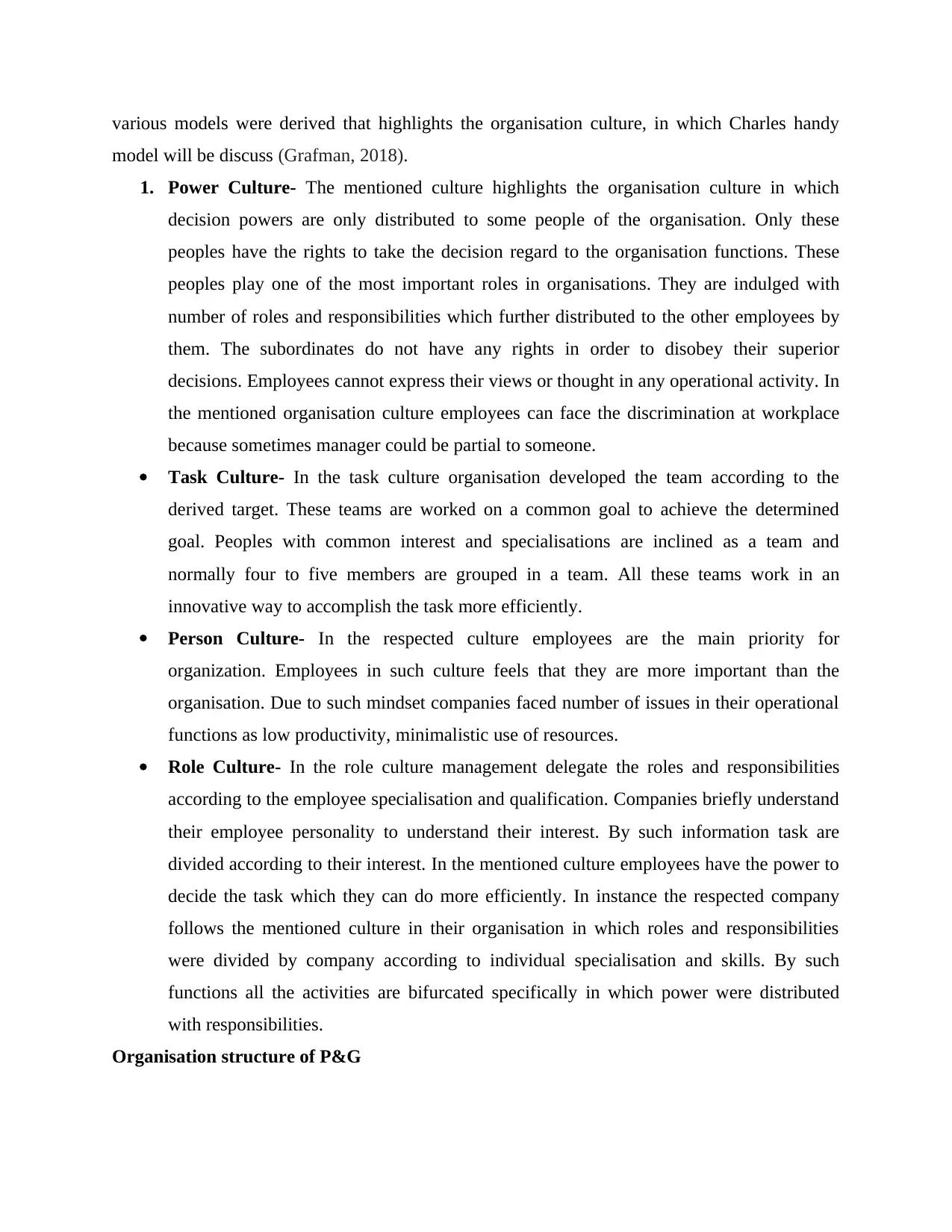
various models were derived that highlights the organisation culture, in which Charles handy
model will be discuss (Grafman, 2018).
1. Power Culture- The mentioned culture highlights the organisation culture in which
decision powers are only distributed to some people of the organisation. Only these
peoples have the rights to take the decision regard to the organisation functions. These
peoples play one of the most important roles in organisations. They are indulged with
number of roles and responsibilities which further distributed to the other employees by
them. The subordinates do not have any rights in order to disobey their superior
decisions. Employees cannot express their views or thought in any operational activity. In
the mentioned organisation culture employees can face the discrimination at workplace
because sometimes manager could be partial to someone.
Task Culture- In the task culture organisation developed the team according to the
derived target. These teams are worked on a common goal to achieve the determined
goal. Peoples with common interest and specialisations are inclined as a team and
normally four to five members are grouped in a team. All these teams work in an
innovative way to accomplish the task more efficiently.
Person Culture- In the respected culture employees are the main priority for
organization. Employees in such culture feels that they are more important than the
organisation. Due to such mindset companies faced number of issues in their operational
functions as low productivity, minimalistic use of resources.
Role Culture- In the role culture management delegate the roles and responsibilities
according to the employee specialisation and qualification. Companies briefly understand
their employee personality to understand their interest. By such information task are
divided according to their interest. In the mentioned culture employees have the power to
decide the task which they can do more efficiently. In instance the respected company
follows the mentioned culture in their organisation in which roles and responsibilities
were divided by company according to individual specialisation and skills. By such
functions all the activities are bifurcated specifically in which power were distributed
with responsibilities.
Organisation structure of P&G
model will be discuss (Grafman, 2018).
1. Power Culture- The mentioned culture highlights the organisation culture in which
decision powers are only distributed to some people of the organisation. Only these
peoples have the rights to take the decision regard to the organisation functions. These
peoples play one of the most important roles in organisations. They are indulged with
number of roles and responsibilities which further distributed to the other employees by
them. The subordinates do not have any rights in order to disobey their superior
decisions. Employees cannot express their views or thought in any operational activity. In
the mentioned organisation culture employees can face the discrimination at workplace
because sometimes manager could be partial to someone.
Task Culture- In the task culture organisation developed the team according to the
derived target. These teams are worked on a common goal to achieve the determined
goal. Peoples with common interest and specialisations are inclined as a team and
normally four to five members are grouped in a team. All these teams work in an
innovative way to accomplish the task more efficiently.
Person Culture- In the respected culture employees are the main priority for
organization. Employees in such culture feels that they are more important than the
organisation. Due to such mindset companies faced number of issues in their operational
functions as low productivity, minimalistic use of resources.
Role Culture- In the role culture management delegate the roles and responsibilities
according to the employee specialisation and qualification. Companies briefly understand
their employee personality to understand their interest. By such information task are
divided according to their interest. In the mentioned culture employees have the power to
decide the task which they can do more efficiently. In instance the respected company
follows the mentioned culture in their organisation in which roles and responsibilities
were divided by company according to individual specialisation and skills. By such
functions all the activities are bifurcated specifically in which power were distributed
with responsibilities.
Organisation structure of P&G
Paraphrase This Document
Need a fresh take? Get an instant paraphrase of this document with our AI Paraphraser
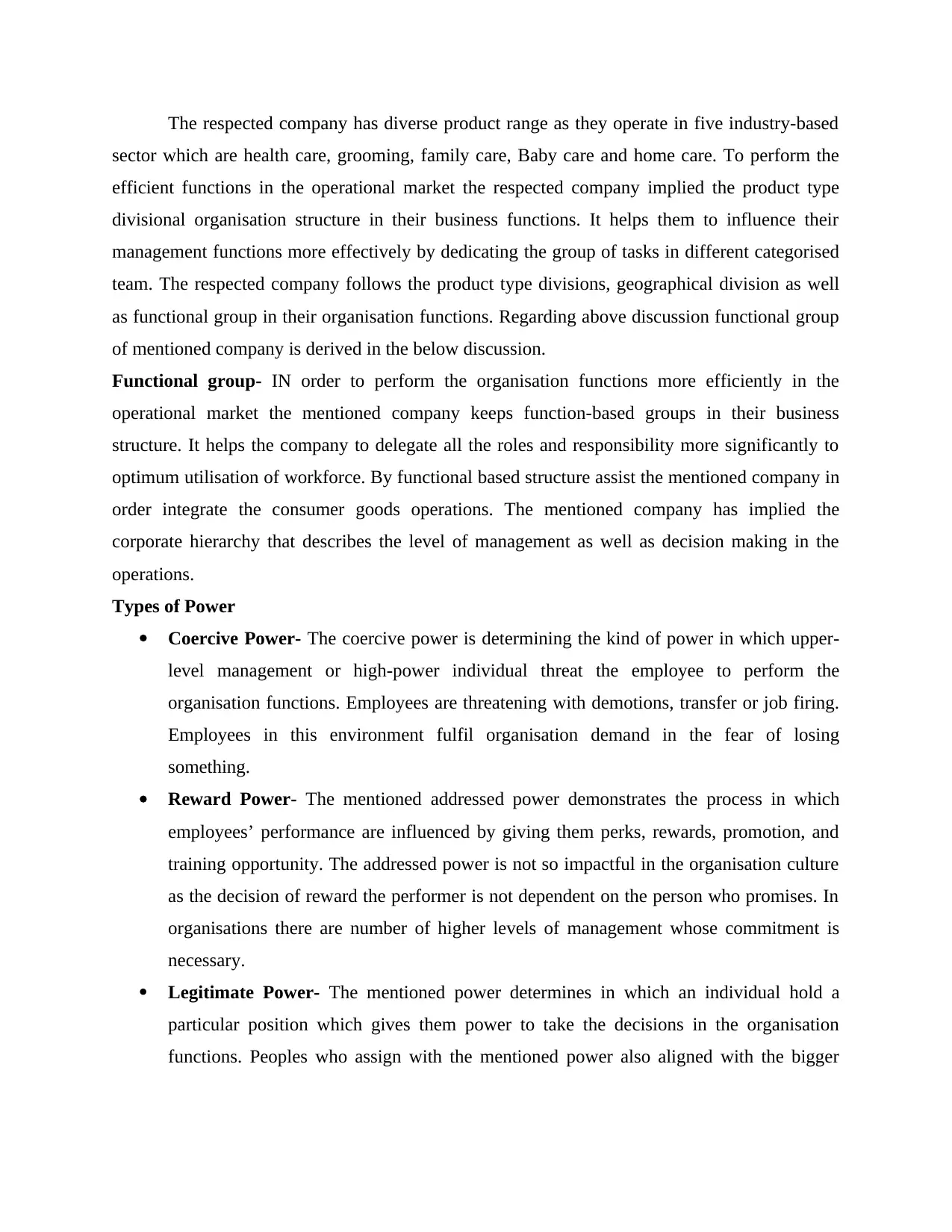
The respected company has diverse product range as they operate in five industry-based
sector which are health care, grooming, family care, Baby care and home care. To perform the
efficient functions in the operational market the respected company implied the product type
divisional organisation structure in their business functions. It helps them to influence their
management functions more effectively by dedicating the group of tasks in different categorised
team. The respected company follows the product type divisions, geographical division as well
as functional group in their organisation functions. Regarding above discussion functional group
of mentioned company is derived in the below discussion.
Functional group- IN order to perform the organisation functions more efficiently in the
operational market the mentioned company keeps function-based groups in their business
structure. It helps the company to delegate all the roles and responsibility more significantly to
optimum utilisation of workforce. By functional based structure assist the mentioned company in
order integrate the consumer goods operations. The mentioned company has implied the
corporate hierarchy that describes the level of management as well as decision making in the
operations.
Types of Power
Coercive Power- The coercive power is determining the kind of power in which upper-
level management or high-power individual threat the employee to perform the
organisation functions. Employees are threatening with demotions, transfer or job firing.
Employees in this environment fulfil organisation demand in the fear of losing
something.
Reward Power- The mentioned addressed power demonstrates the process in which
employees’ performance are influenced by giving them perks, rewards, promotion, and
training opportunity. The addressed power is not so impactful in the organisation culture
as the decision of reward the performer is not dependent on the person who promises. In
organisations there are number of higher levels of management whose commitment is
necessary.
Legitimate Power- The mentioned power determines in which an individual hold a
particular position which gives them power to take the decisions in the organisation
functions. Peoples who assign with the mentioned power also aligned with the bigger
sector which are health care, grooming, family care, Baby care and home care. To perform the
efficient functions in the operational market the respected company implied the product type
divisional organisation structure in their business functions. It helps them to influence their
management functions more effectively by dedicating the group of tasks in different categorised
team. The respected company follows the product type divisions, geographical division as well
as functional group in their organisation functions. Regarding above discussion functional group
of mentioned company is derived in the below discussion.
Functional group- IN order to perform the organisation functions more efficiently in the
operational market the mentioned company keeps function-based groups in their business
structure. It helps the company to delegate all the roles and responsibility more significantly to
optimum utilisation of workforce. By functional based structure assist the mentioned company in
order integrate the consumer goods operations. The mentioned company has implied the
corporate hierarchy that describes the level of management as well as decision making in the
operations.
Types of Power
Coercive Power- The coercive power is determining the kind of power in which upper-
level management or high-power individual threat the employee to perform the
organisation functions. Employees are threatening with demotions, transfer or job firing.
Employees in this environment fulfil organisation demand in the fear of losing
something.
Reward Power- The mentioned addressed power demonstrates the process in which
employees’ performance are influenced by giving them perks, rewards, promotion, and
training opportunity. The addressed power is not so impactful in the organisation culture
as the decision of reward the performer is not dependent on the person who promises. In
organisations there are number of higher levels of management whose commitment is
necessary.
Legitimate Power- The mentioned power determines in which an individual hold a
particular position which gives them power to take the decisions in the organisation
functions. Peoples who assign with the mentioned power also aligned with the bigger
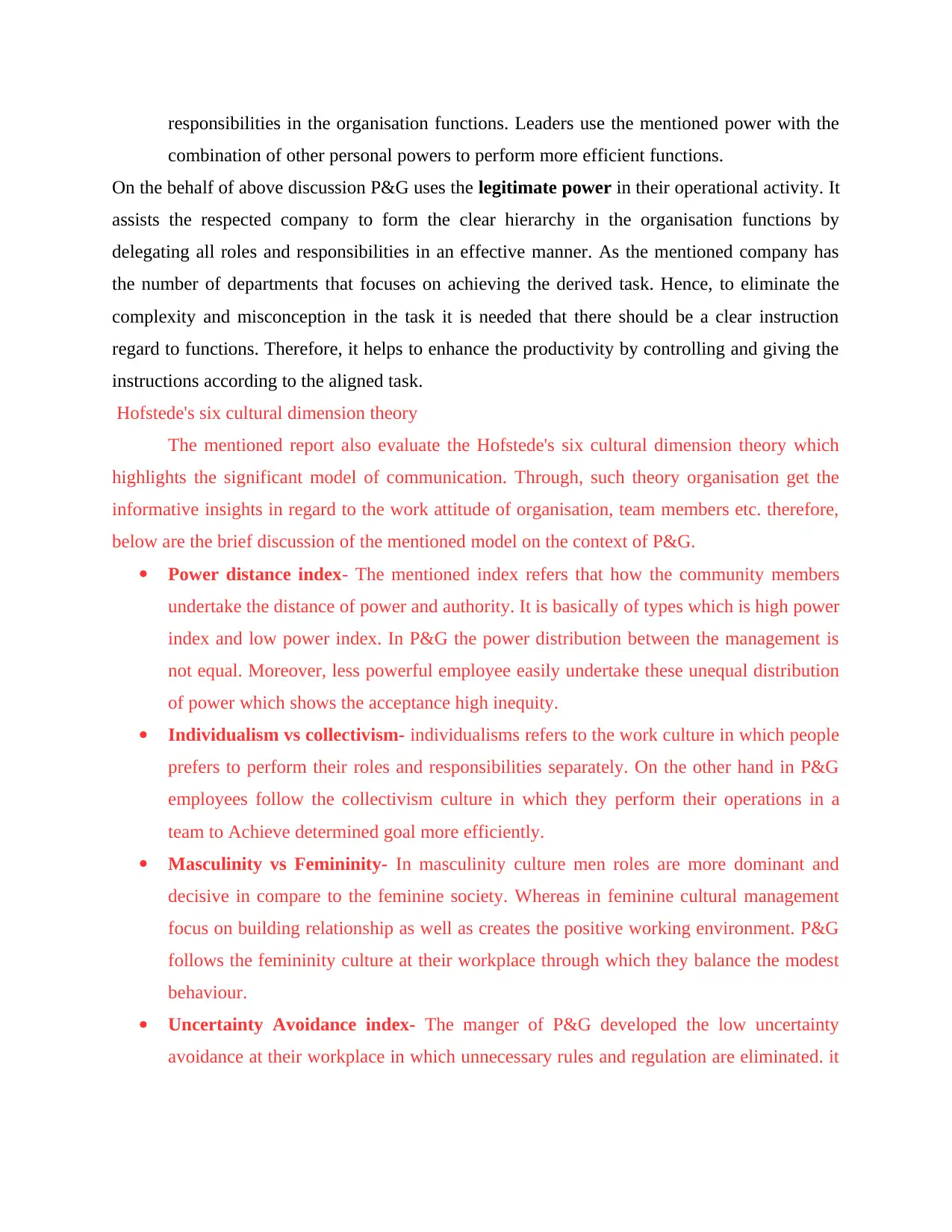
responsibilities in the organisation functions. Leaders use the mentioned power with the
combination of other personal powers to perform more efficient functions.
On the behalf of above discussion P&G uses the legitimate power in their operational activity. It
assists the respected company to form the clear hierarchy in the organisation functions by
delegating all roles and responsibilities in an effective manner. As the mentioned company has
the number of departments that focuses on achieving the derived task. Hence, to eliminate the
complexity and misconception in the task it is needed that there should be a clear instruction
regard to functions. Therefore, it helps to enhance the productivity by controlling and giving the
instructions according to the aligned task.
Hofstede's six cultural dimension theory
The mentioned report also evaluate the Hofstede's six cultural dimension theory which
highlights the significant model of communication. Through, such theory organisation get the
informative insights in regard to the work attitude of organisation, team members etc. therefore,
below are the brief discussion of the mentioned model on the context of P&G.
Power distance index- The mentioned index refers that how the community members
undertake the distance of power and authority. It is basically of types which is high power
index and low power index. In P&G the power distribution between the management is
not equal. Moreover, less powerful employee easily undertake these unequal distribution
of power which shows the acceptance high inequity.
Individualism vs collectivism- individualisms refers to the work culture in which people
prefers to perform their roles and responsibilities separately. On the other hand in P&G
employees follow the collectivism culture in which they perform their operations in a
team to Achieve determined goal more efficiently.
Masculinity vs Femininity- In masculinity culture men roles are more dominant and
decisive in compare to the feminine society. Whereas in feminine cultural management
focus on building relationship as well as creates the positive working environment. P&G
follows the femininity culture at their workplace through which they balance the modest
behaviour.
Uncertainty Avoidance index- The manger of P&G developed the low uncertainty
avoidance at their workplace in which unnecessary rules and regulation are eliminated. it
combination of other personal powers to perform more efficient functions.
On the behalf of above discussion P&G uses the legitimate power in their operational activity. It
assists the respected company to form the clear hierarchy in the organisation functions by
delegating all roles and responsibilities in an effective manner. As the mentioned company has
the number of departments that focuses on achieving the derived task. Hence, to eliminate the
complexity and misconception in the task it is needed that there should be a clear instruction
regard to functions. Therefore, it helps to enhance the productivity by controlling and giving the
instructions according to the aligned task.
Hofstede's six cultural dimension theory
The mentioned report also evaluate the Hofstede's six cultural dimension theory which
highlights the significant model of communication. Through, such theory organisation get the
informative insights in regard to the work attitude of organisation, team members etc. therefore,
below are the brief discussion of the mentioned model on the context of P&G.
Power distance index- The mentioned index refers that how the community members
undertake the distance of power and authority. It is basically of types which is high power
index and low power index. In P&G the power distribution between the management is
not equal. Moreover, less powerful employee easily undertake these unequal distribution
of power which shows the acceptance high inequity.
Individualism vs collectivism- individualisms refers to the work culture in which people
prefers to perform their roles and responsibilities separately. On the other hand in P&G
employees follow the collectivism culture in which they perform their operations in a
team to Achieve determined goal more efficiently.
Masculinity vs Femininity- In masculinity culture men roles are more dominant and
decisive in compare to the feminine society. Whereas in feminine cultural management
focus on building relationship as well as creates the positive working environment. P&G
follows the femininity culture at their workplace through which they balance the modest
behaviour.
Uncertainty Avoidance index- The manger of P&G developed the low uncertainty
avoidance at their workplace in which unnecessary rules and regulation are eliminated. it
⊘ This is a preview!⊘
Do you want full access?
Subscribe today to unlock all pages.

Trusted by 1+ million students worldwide
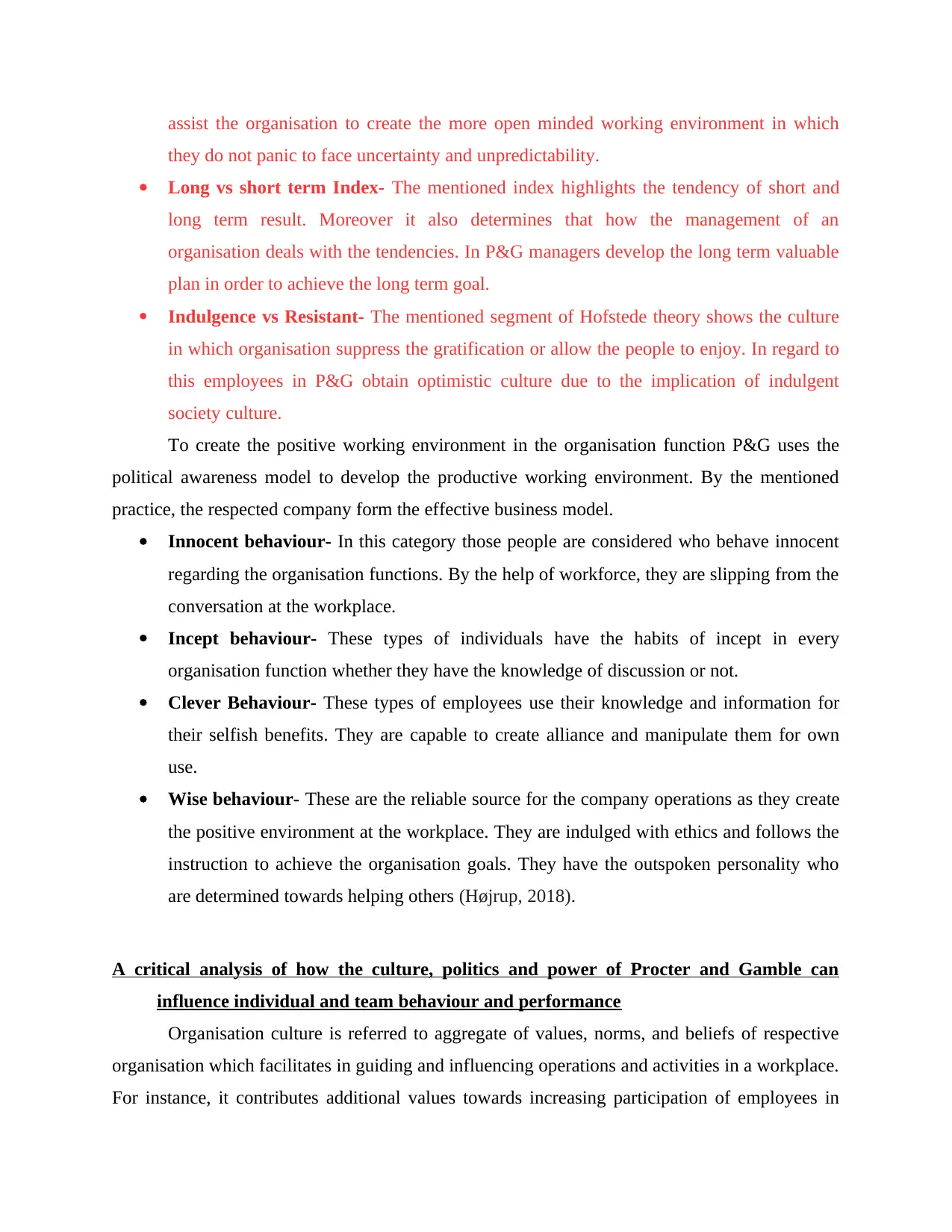
assist the organisation to create the more open minded working environment in which
they do not panic to face uncertainty and unpredictability.
Long vs short term Index- The mentioned index highlights the tendency of short and
long term result. Moreover it also determines that how the management of an
organisation deals with the tendencies. In P&G managers develop the long term valuable
plan in order to achieve the long term goal.
Indulgence vs Resistant- The mentioned segment of Hofstede theory shows the culture
in which organisation suppress the gratification or allow the people to enjoy. In regard to
this employees in P&G obtain optimistic culture due to the implication of indulgent
society culture.
To create the positive working environment in the organisation function P&G uses the
political awareness model to develop the productive working environment. By the mentioned
practice, the respected company form the effective business model.
Innocent behaviour- In this category those people are considered who behave innocent
regarding the organisation functions. By the help of workforce, they are slipping from the
conversation at the workplace.
Incept behaviour- These types of individuals have the habits of incept in every
organisation function whether they have the knowledge of discussion or not.
Clever Behaviour- These types of employees use their knowledge and information for
their selfish benefits. They are capable to create alliance and manipulate them for own
use.
Wise behaviour- These are the reliable source for the company operations as they create
the positive environment at the workplace. They are indulged with ethics and follows the
instruction to achieve the organisation goals. They have the outspoken personality who
are determined towards helping others (Højrup, 2018).
A critical analysis of how the culture, politics and power of Procter and Gamble can
influence individual and team behaviour and performance
Organisation culture is referred to aggregate of values, norms, and beliefs of respective
organisation which facilitates in guiding and influencing operations and activities in a workplace.
For instance, it contributes additional values towards increasing participation of employees in
they do not panic to face uncertainty and unpredictability.
Long vs short term Index- The mentioned index highlights the tendency of short and
long term result. Moreover it also determines that how the management of an
organisation deals with the tendencies. In P&G managers develop the long term valuable
plan in order to achieve the long term goal.
Indulgence vs Resistant- The mentioned segment of Hofstede theory shows the culture
in which organisation suppress the gratification or allow the people to enjoy. In regard to
this employees in P&G obtain optimistic culture due to the implication of indulgent
society culture.
To create the positive working environment in the organisation function P&G uses the
political awareness model to develop the productive working environment. By the mentioned
practice, the respected company form the effective business model.
Innocent behaviour- In this category those people are considered who behave innocent
regarding the organisation functions. By the help of workforce, they are slipping from the
conversation at the workplace.
Incept behaviour- These types of individuals have the habits of incept in every
organisation function whether they have the knowledge of discussion or not.
Clever Behaviour- These types of employees use their knowledge and information for
their selfish benefits. They are capable to create alliance and manipulate them for own
use.
Wise behaviour- These are the reliable source for the company operations as they create
the positive environment at the workplace. They are indulged with ethics and follows the
instruction to achieve the organisation goals. They have the outspoken personality who
are determined towards helping others (Højrup, 2018).
A critical analysis of how the culture, politics and power of Procter and Gamble can
influence individual and team behaviour and performance
Organisation culture is referred to aggregate of values, norms, and beliefs of respective
organisation which facilitates in guiding and influencing operations and activities in a workplace.
For instance, it contributes additional values towards increasing participation of employees in
Paraphrase This Document
Need a fresh take? Get an instant paraphrase of this document with our AI Paraphraser
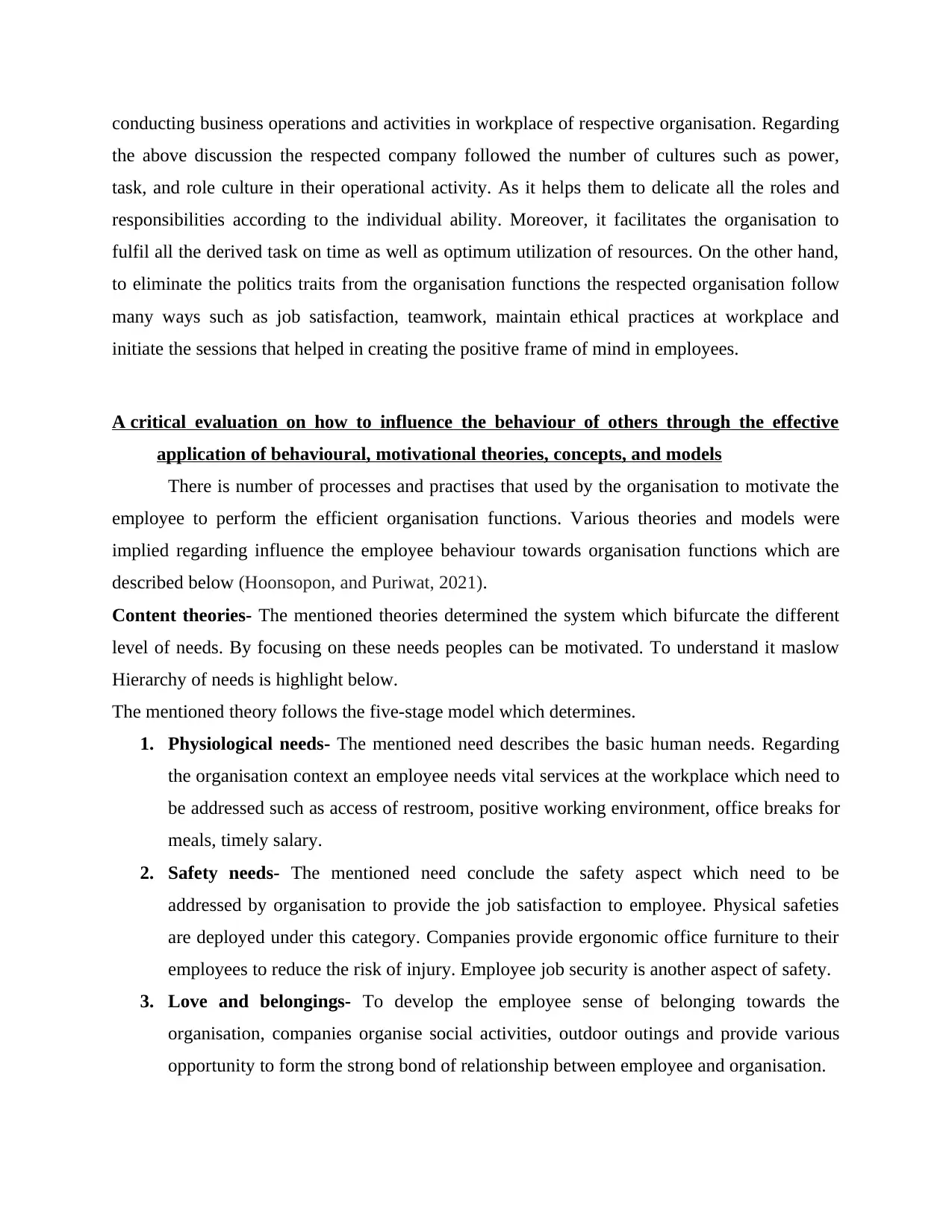
conducting business operations and activities in workplace of respective organisation. Regarding
the above discussion the respected company followed the number of cultures such as power,
task, and role culture in their operational activity. As it helps them to delicate all the roles and
responsibilities according to the individual ability. Moreover, it facilitates the organisation to
fulfil all the derived task on time as well as optimum utilization of resources. On the other hand,
to eliminate the politics traits from the organisation functions the respected organisation follow
many ways such as job satisfaction, teamwork, maintain ethical practices at workplace and
initiate the sessions that helped in creating the positive frame of mind in employees.
A critical evaluation on how to influence the behaviour of others through the effective
application of behavioural, motivational theories, concepts, and models
There is number of processes and practises that used by the organisation to motivate the
employee to perform the efficient organisation functions. Various theories and models were
implied regarding influence the employee behaviour towards organisation functions which are
described below (Hoonsopon, and Puriwat, 2021).
Content theories- The mentioned theories determined the system which bifurcate the different
level of needs. By focusing on these needs peoples can be motivated. To understand it maslow
Hierarchy of needs is highlight below.
The mentioned theory follows the five-stage model which determines.
1. Physiological needs- The mentioned need describes the basic human needs. Regarding
the organisation context an employee needs vital services at the workplace which need to
be addressed such as access of restroom, positive working environment, office breaks for
meals, timely salary.
2. Safety needs- The mentioned need conclude the safety aspect which need to be
addressed by organisation to provide the job satisfaction to employee. Physical safeties
are deployed under this category. Companies provide ergonomic office furniture to their
employees to reduce the risk of injury. Employee job security is another aspect of safety.
3. Love and belongings- To develop the employee sense of belonging towards the
organisation, companies organise social activities, outdoor outings and provide various
opportunity to form the strong bond of relationship between employee and organisation.
the above discussion the respected company followed the number of cultures such as power,
task, and role culture in their operational activity. As it helps them to delicate all the roles and
responsibilities according to the individual ability. Moreover, it facilitates the organisation to
fulfil all the derived task on time as well as optimum utilization of resources. On the other hand,
to eliminate the politics traits from the organisation functions the respected organisation follow
many ways such as job satisfaction, teamwork, maintain ethical practices at workplace and
initiate the sessions that helped in creating the positive frame of mind in employees.
A critical evaluation on how to influence the behaviour of others through the effective
application of behavioural, motivational theories, concepts, and models
There is number of processes and practises that used by the organisation to motivate the
employee to perform the efficient organisation functions. Various theories and models were
implied regarding influence the employee behaviour towards organisation functions which are
described below (Hoonsopon, and Puriwat, 2021).
Content theories- The mentioned theories determined the system which bifurcate the different
level of needs. By focusing on these needs peoples can be motivated. To understand it maslow
Hierarchy of needs is highlight below.
The mentioned theory follows the five-stage model which determines.
1. Physiological needs- The mentioned need describes the basic human needs. Regarding
the organisation context an employee needs vital services at the workplace which need to
be addressed such as access of restroom, positive working environment, office breaks for
meals, timely salary.
2. Safety needs- The mentioned need conclude the safety aspect which need to be
addressed by organisation to provide the job satisfaction to employee. Physical safeties
are deployed under this category. Companies provide ergonomic office furniture to their
employees to reduce the risk of injury. Employee job security is another aspect of safety.
3. Love and belongings- To develop the employee sense of belonging towards the
organisation, companies organise social activities, outdoor outings and provide various
opportunity to form the strong bond of relationship between employee and organisation.
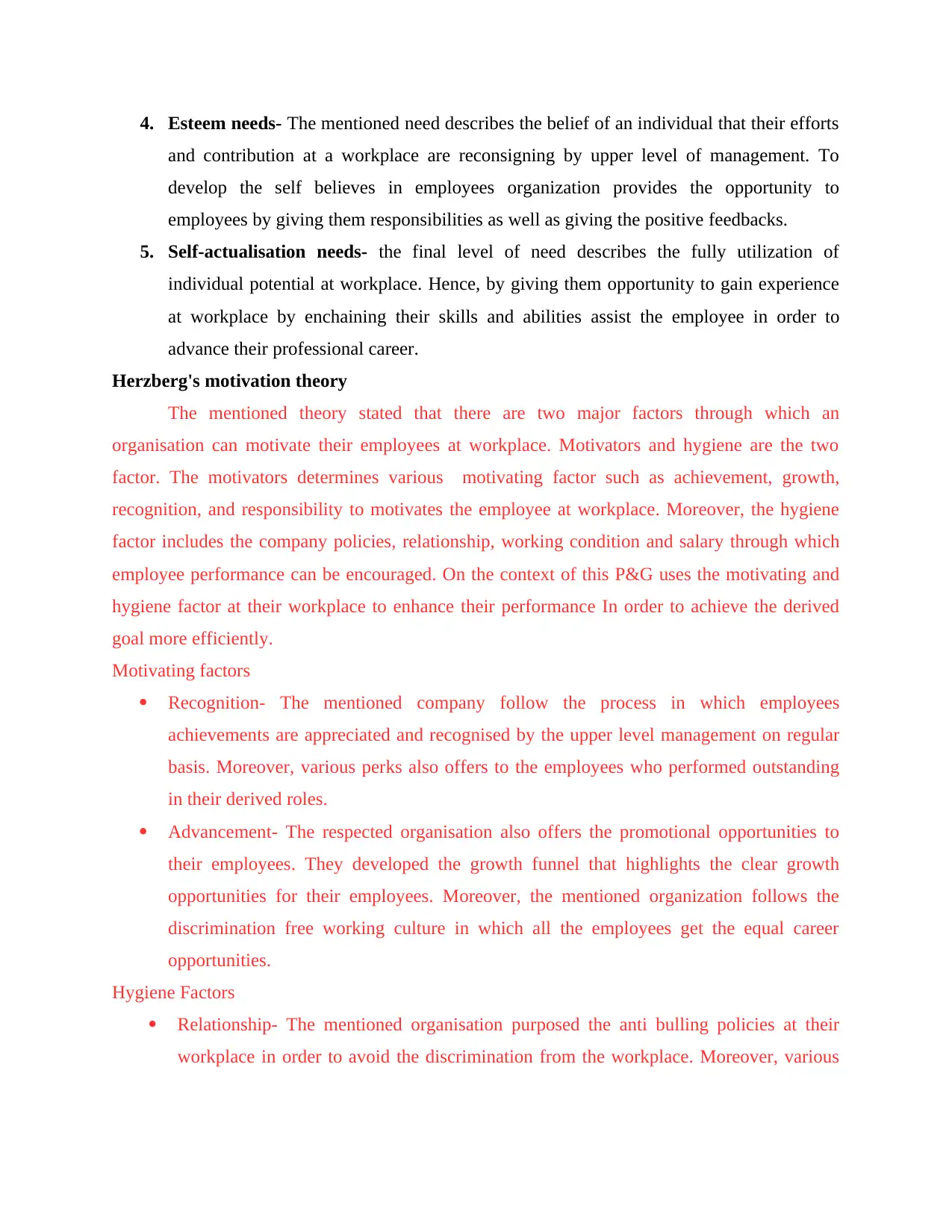
4. Esteem needs- The mentioned need describes the belief of an individual that their efforts
and contribution at a workplace are reconsigning by upper level of management. To
develop the self believes in employees organization provides the opportunity to
employees by giving them responsibilities as well as giving the positive feedbacks.
5. Self-actualisation needs- the final level of need describes the fully utilization of
individual potential at workplace. Hence, by giving them opportunity to gain experience
at workplace by enchaining their skills and abilities assist the employee in order to
advance their professional career.
Herzberg's motivation theory
The mentioned theory stated that there are two major factors through which an
organisation can motivate their employees at workplace. Motivators and hygiene are the two
factor. The motivators determines various motivating factor such as achievement, growth,
recognition, and responsibility to motivates the employee at workplace. Moreover, the hygiene
factor includes the company policies, relationship, working condition and salary through which
employee performance can be encouraged. On the context of this P&G uses the motivating and
hygiene factor at their workplace to enhance their performance In order to achieve the derived
goal more efficiently.
Motivating factors
Recognition- The mentioned company follow the process in which employees
achievements are appreciated and recognised by the upper level management on regular
basis. Moreover, various perks also offers to the employees who performed outstanding
in their derived roles.
Advancement- The respected organisation also offers the promotional opportunities to
their employees. They developed the growth funnel that highlights the clear growth
opportunities for their employees. Moreover, the mentioned organization follows the
discrimination free working culture in which all the employees get the equal career
opportunities.
Hygiene Factors
Relationship- The mentioned organisation purposed the anti bulling policies at their
workplace in order to avoid the discrimination from the workplace. Moreover, various
and contribution at a workplace are reconsigning by upper level of management. To
develop the self believes in employees organization provides the opportunity to
employees by giving them responsibilities as well as giving the positive feedbacks.
5. Self-actualisation needs- the final level of need describes the fully utilization of
individual potential at workplace. Hence, by giving them opportunity to gain experience
at workplace by enchaining their skills and abilities assist the employee in order to
advance their professional career.
Herzberg's motivation theory
The mentioned theory stated that there are two major factors through which an
organisation can motivate their employees at workplace. Motivators and hygiene are the two
factor. The motivators determines various motivating factor such as achievement, growth,
recognition, and responsibility to motivates the employee at workplace. Moreover, the hygiene
factor includes the company policies, relationship, working condition and salary through which
employee performance can be encouraged. On the context of this P&G uses the motivating and
hygiene factor at their workplace to enhance their performance In order to achieve the derived
goal more efficiently.
Motivating factors
Recognition- The mentioned company follow the process in which employees
achievements are appreciated and recognised by the upper level management on regular
basis. Moreover, various perks also offers to the employees who performed outstanding
in their derived roles.
Advancement- The respected organisation also offers the promotional opportunities to
their employees. They developed the growth funnel that highlights the clear growth
opportunities for their employees. Moreover, the mentioned organization follows the
discrimination free working culture in which all the employees get the equal career
opportunities.
Hygiene Factors
Relationship- The mentioned organisation purposed the anti bulling policies at their
workplace in order to avoid the discrimination from the workplace. Moreover, various
⊘ This is a preview!⊘
Do you want full access?
Subscribe today to unlock all pages.

Trusted by 1+ million students worldwide
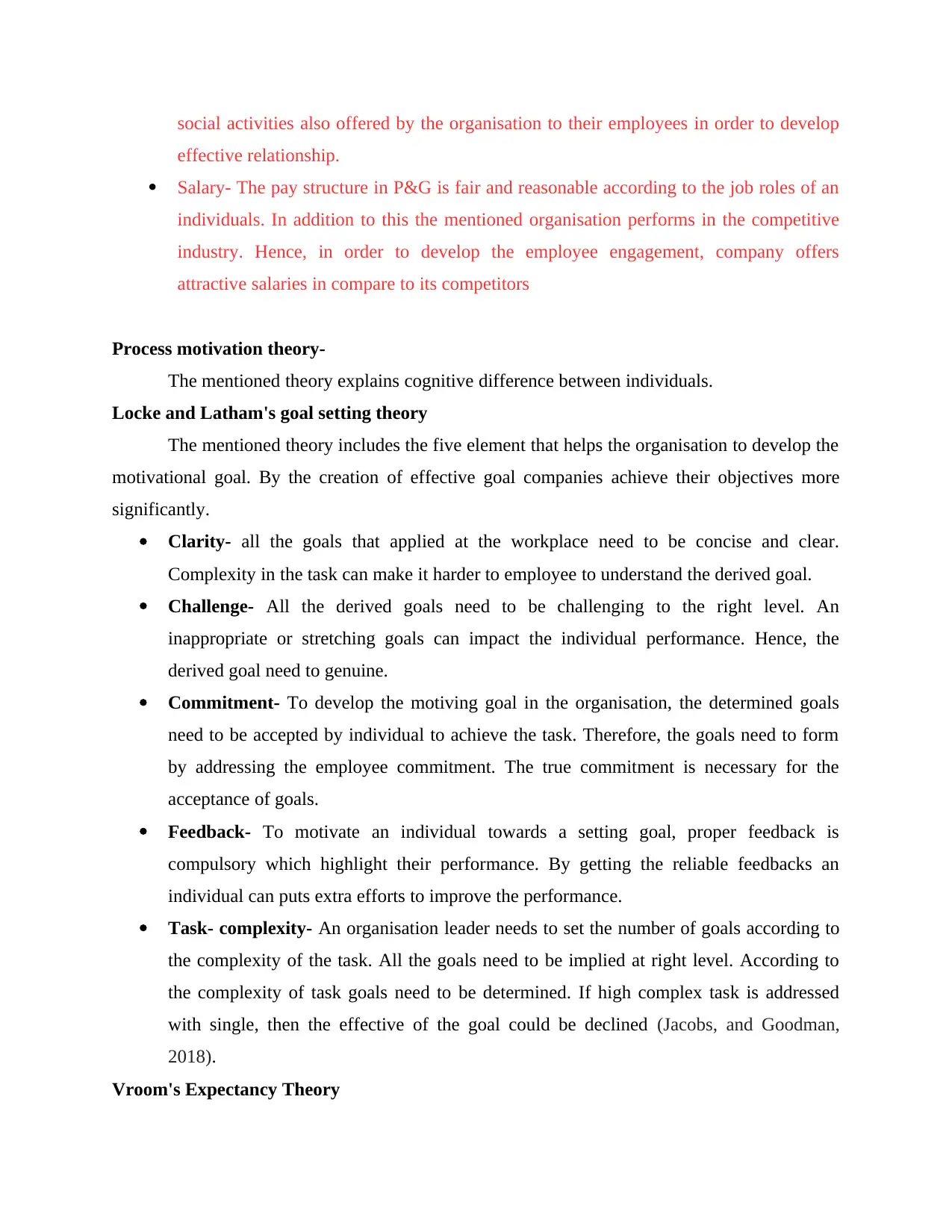
social activities also offered by the organisation to their employees in order to develop
effective relationship.
Salary- The pay structure in P&G is fair and reasonable according to the job roles of an
individuals. In addition to this the mentioned organisation performs in the competitive
industry. Hence, in order to develop the employee engagement, company offers
attractive salaries in compare to its competitors
Process motivation theory-
The mentioned theory explains cognitive difference between individuals.
Locke and Latham's goal setting theory
The mentioned theory includes the five element that helps the organisation to develop the
motivational goal. By the creation of effective goal companies achieve their objectives more
significantly.
Clarity- all the goals that applied at the workplace need to be concise and clear.
Complexity in the task can make it harder to employee to understand the derived goal.
Challenge- All the derived goals need to be challenging to the right level. An
inappropriate or stretching goals can impact the individual performance. Hence, the
derived goal need to genuine.
Commitment- To develop the motiving goal in the organisation, the determined goals
need to be accepted by individual to achieve the task. Therefore, the goals need to form
by addressing the employee commitment. The true commitment is necessary for the
acceptance of goals.
Feedback- To motivate an individual towards a setting goal, proper feedback is
compulsory which highlight their performance. By getting the reliable feedbacks an
individual can puts extra efforts to improve the performance.
Task- complexity- An organisation leader needs to set the number of goals according to
the complexity of the task. All the goals need to be implied at right level. According to
the complexity of task goals need to be determined. If high complex task is addressed
with single, then the effective of the goal could be declined (Jacobs, and Goodman,
2018).
Vroom's Expectancy Theory
effective relationship.
Salary- The pay structure in P&G is fair and reasonable according to the job roles of an
individuals. In addition to this the mentioned organisation performs in the competitive
industry. Hence, in order to develop the employee engagement, company offers
attractive salaries in compare to its competitors
Process motivation theory-
The mentioned theory explains cognitive difference between individuals.
Locke and Latham's goal setting theory
The mentioned theory includes the five element that helps the organisation to develop the
motivational goal. By the creation of effective goal companies achieve their objectives more
significantly.
Clarity- all the goals that applied at the workplace need to be concise and clear.
Complexity in the task can make it harder to employee to understand the derived goal.
Challenge- All the derived goals need to be challenging to the right level. An
inappropriate or stretching goals can impact the individual performance. Hence, the
derived goal need to genuine.
Commitment- To develop the motiving goal in the organisation, the determined goals
need to be accepted by individual to achieve the task. Therefore, the goals need to form
by addressing the employee commitment. The true commitment is necessary for the
acceptance of goals.
Feedback- To motivate an individual towards a setting goal, proper feedback is
compulsory which highlight their performance. By getting the reliable feedbacks an
individual can puts extra efforts to improve the performance.
Task- complexity- An organisation leader needs to set the number of goals according to
the complexity of the task. All the goals need to be implied at right level. According to
the complexity of task goals need to be determined. If high complex task is addressed
with single, then the effective of the goal could be declined (Jacobs, and Goodman,
2018).
Vroom's Expectancy Theory
Paraphrase This Document
Need a fresh take? Get an instant paraphrase of this document with our AI Paraphraser
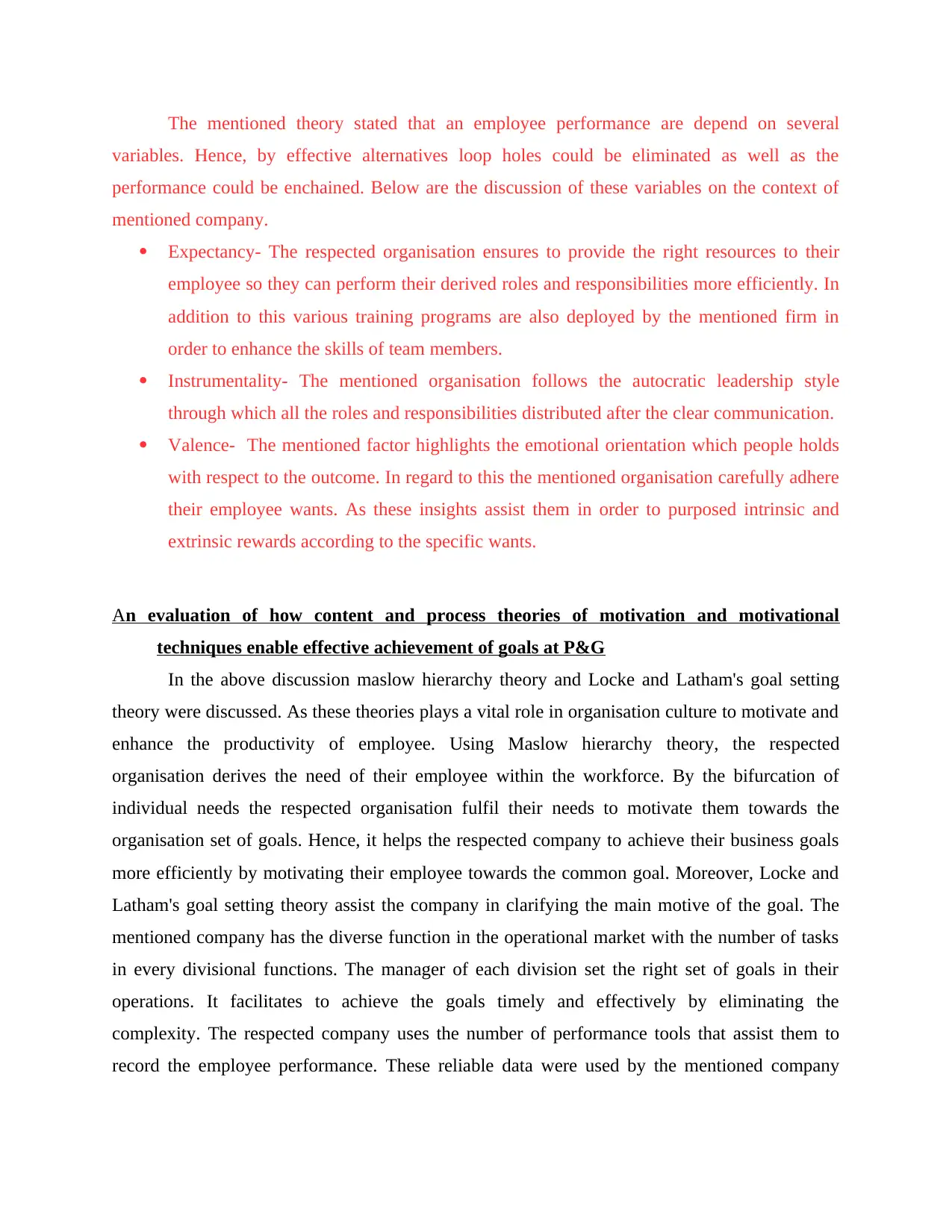
The mentioned theory stated that an employee performance are depend on several
variables. Hence, by effective alternatives loop holes could be eliminated as well as the
performance could be enchained. Below are the discussion of these variables on the context of
mentioned company.
Expectancy- The respected organisation ensures to provide the right resources to their
employee so they can perform their derived roles and responsibilities more efficiently. In
addition to this various training programs are also deployed by the mentioned firm in
order to enhance the skills of team members.
Instrumentality- The mentioned organisation follows the autocratic leadership style
through which all the roles and responsibilities distributed after the clear communication.
Valence- The mentioned factor highlights the emotional orientation which people holds
with respect to the outcome. In regard to this the mentioned organisation carefully adhere
their employee wants. As these insights assist them in order to purposed intrinsic and
extrinsic rewards according to the specific wants.
An evaluation of how content and process theories of motivation and motivational
techniques enable effective achievement of goals at P&G
In the above discussion maslow hierarchy theory and Locke and Latham's goal setting
theory were discussed. As these theories plays a vital role in organisation culture to motivate and
enhance the productivity of employee. Using Maslow hierarchy theory, the respected
organisation derives the need of their employee within the workforce. By the bifurcation of
individual needs the respected organisation fulfil their needs to motivate them towards the
organisation set of goals. Hence, it helps the respected company to achieve their business goals
more efficiently by motivating their employee towards the common goal. Moreover, Locke and
Latham's goal setting theory assist the company in clarifying the main motive of the goal. The
mentioned company has the diverse function in the operational market with the number of tasks
in every divisional functions. The manager of each division set the right set of goals in their
operations. It facilitates to achieve the goals timely and effectively by eliminating the
complexity. The respected company uses the number of performance tools that assist them to
record the employee performance. These reliable data were used by the mentioned company
variables. Hence, by effective alternatives loop holes could be eliminated as well as the
performance could be enchained. Below are the discussion of these variables on the context of
mentioned company.
Expectancy- The respected organisation ensures to provide the right resources to their
employee so they can perform their derived roles and responsibilities more efficiently. In
addition to this various training programs are also deployed by the mentioned firm in
order to enhance the skills of team members.
Instrumentality- The mentioned organisation follows the autocratic leadership style
through which all the roles and responsibilities distributed after the clear communication.
Valence- The mentioned factor highlights the emotional orientation which people holds
with respect to the outcome. In regard to this the mentioned organisation carefully adhere
their employee wants. As these insights assist them in order to purposed intrinsic and
extrinsic rewards according to the specific wants.
An evaluation of how content and process theories of motivation and motivational
techniques enable effective achievement of goals at P&G
In the above discussion maslow hierarchy theory and Locke and Latham's goal setting
theory were discussed. As these theories plays a vital role in organisation culture to motivate and
enhance the productivity of employee. Using Maslow hierarchy theory, the respected
organisation derives the need of their employee within the workforce. By the bifurcation of
individual needs the respected organisation fulfil their needs to motivate them towards the
organisation set of goals. Hence, it helps the respected company to achieve their business goals
more efficiently by motivating their employee towards the common goal. Moreover, Locke and
Latham's goal setting theory assist the company in clarifying the main motive of the goal. The
mentioned company has the diverse function in the operational market with the number of tasks
in every divisional functions. The manager of each division set the right set of goals in their
operations. It facilitates to achieve the goals timely and effectively by eliminating the
complexity. The respected company uses the number of performance tools that assist them to
record the employee performance. These reliable data were used by the mentioned company
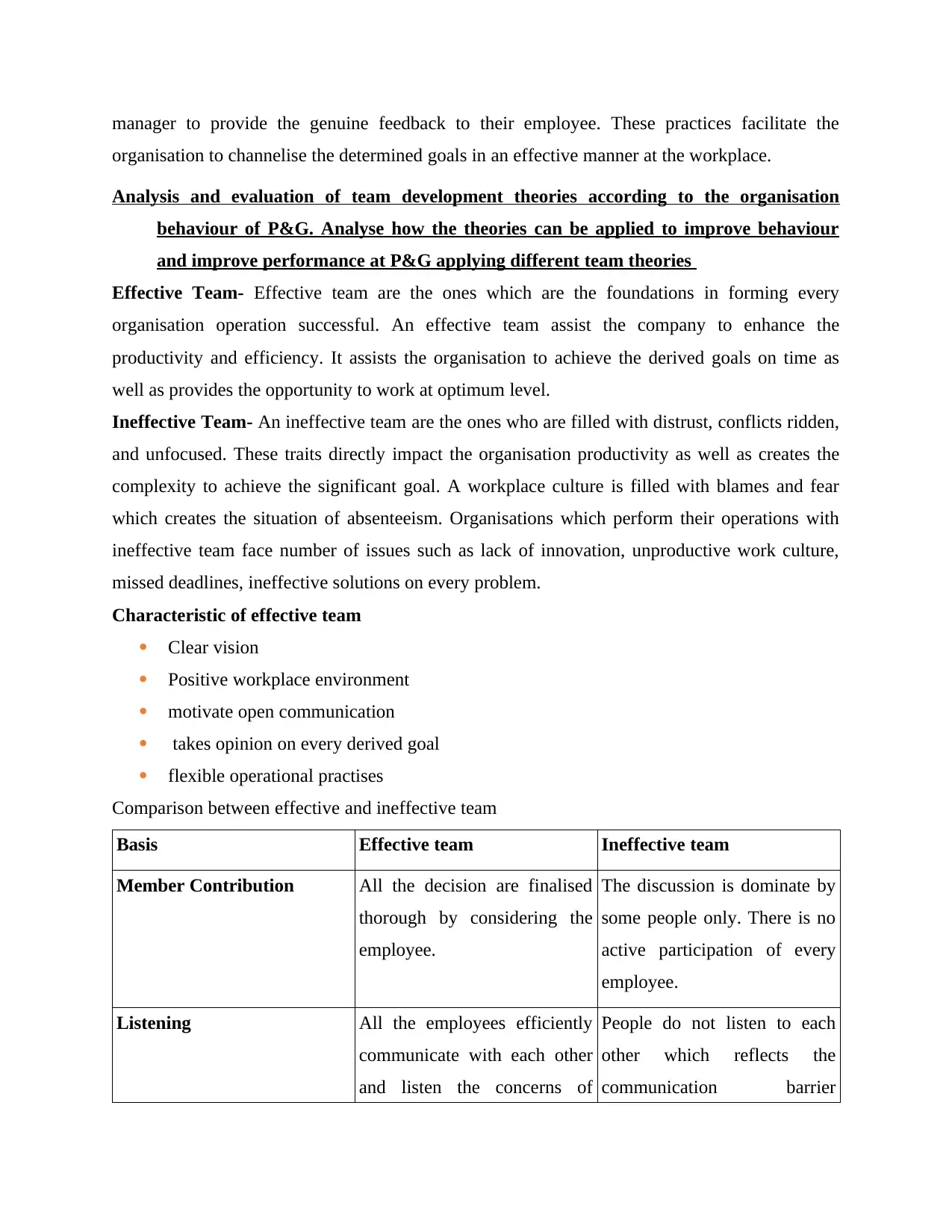
manager to provide the genuine feedback to their employee. These practices facilitate the
organisation to channelise the determined goals in an effective manner at the workplace.
Analysis and evaluation of team development theories according to the organisation
behaviour of P&G. Analyse how the theories can be applied to improve behaviour
and improve performance at P&G applying different team theories
Effective Team- Effective team are the ones which are the foundations in forming every
organisation operation successful. An effective team assist the company to enhance the
productivity and efficiency. It assists the organisation to achieve the derived goals on time as
well as provides the opportunity to work at optimum level.
Ineffective Team- An ineffective team are the ones who are filled with distrust, conflicts ridden,
and unfocused. These traits directly impact the organisation productivity as well as creates the
complexity to achieve the significant goal. A workplace culture is filled with blames and fear
which creates the situation of absenteeism. Organisations which perform their operations with
ineffective team face number of issues such as lack of innovation, unproductive work culture,
missed deadlines, ineffective solutions on every problem.
Characteristic of effective team
Clear vision
Positive workplace environment
motivate open communication
takes opinion on every derived goal
flexible operational practises
Comparison between effective and ineffective team
Basis Effective team Ineffective team
Member Contribution All the decision are finalised
thorough by considering the
employee.
The discussion is dominate by
some people only. There is no
active participation of every
employee.
Listening All the employees efficiently
communicate with each other
and listen the concerns of
People do not listen to each
other which reflects the
communication barrier
organisation to channelise the determined goals in an effective manner at the workplace.
Analysis and evaluation of team development theories according to the organisation
behaviour of P&G. Analyse how the theories can be applied to improve behaviour
and improve performance at P&G applying different team theories
Effective Team- Effective team are the ones which are the foundations in forming every
organisation operation successful. An effective team assist the company to enhance the
productivity and efficiency. It assists the organisation to achieve the derived goals on time as
well as provides the opportunity to work at optimum level.
Ineffective Team- An ineffective team are the ones who are filled with distrust, conflicts ridden,
and unfocused. These traits directly impact the organisation productivity as well as creates the
complexity to achieve the significant goal. A workplace culture is filled with blames and fear
which creates the situation of absenteeism. Organisations which perform their operations with
ineffective team face number of issues such as lack of innovation, unproductive work culture,
missed deadlines, ineffective solutions on every problem.
Characteristic of effective team
Clear vision
Positive workplace environment
motivate open communication
takes opinion on every derived goal
flexible operational practises
Comparison between effective and ineffective team
Basis Effective team Ineffective team
Member Contribution All the decision are finalised
thorough by considering the
employee.
The discussion is dominate by
some people only. There is no
active participation of every
employee.
Listening All the employees efficiently
communicate with each other
and listen the concerns of
People do not listen to each
other which reflects the
communication barrier
⊘ This is a preview!⊘
Do you want full access?
Subscribe today to unlock all pages.

Trusted by 1+ million students worldwide
1 out of 18
Related Documents
Your All-in-One AI-Powered Toolkit for Academic Success.
+13062052269
info@desklib.com
Available 24*7 on WhatsApp / Email
![[object Object]](/_next/static/media/star-bottom.7253800d.svg)
Unlock your academic potential
Copyright © 2020–2025 A2Z Services. All Rights Reserved. Developed and managed by ZUCOL.




